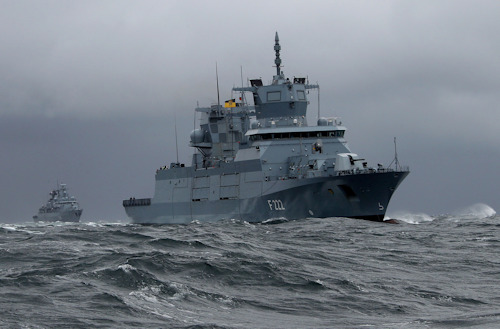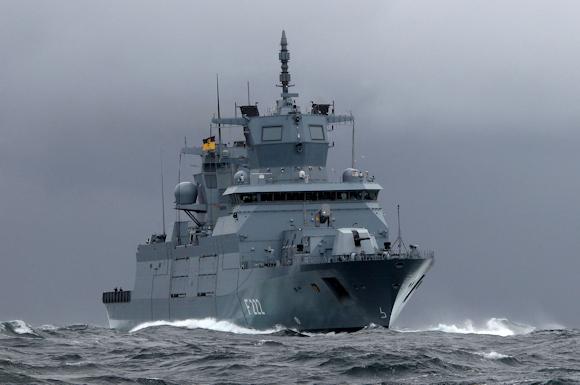F125 is the name of the futuristic design for the Type 125 frigate class Baden-Württemberg. The main mission is to participate in inter-force missions, netcentric, with the ability to fight even asymmetric threats and to carry out stabilization operations using non-lethal weapons. Designed to replace the eight frigates of the F-122 type (class Bremen), commissioned between the 1982 and the 1990, the F-125s are long 149,6 meters and wide 18,8 meters and have a displacement of 7100 tons, with a draft of 5,4 meters. Rather slow (26 nodes only), they are equipped with CODLAG (Combined Diesel eLectric And Gasturbine) propulsion, with four diesel-alternators from 2900 kW each, two electric motors with a unit power of 4500 kW and a turbine with 20 MW of gas. It is interesting to choose not only traditional weapons but also "less lethal" defense systems such as sensors for detecting underwater raiders, water cannons, "dazzler" laser projectors and acoustic cannons. A configuration that evidently would make these ships particularly suitable for operating in low-intensity operating theaters such as anti-piracy and stabilization missions. History, however, teaches that ships that are too specialized have often found themselves not exactly in the scenario taken as a reference for their definition. Military ships have an average life of 20 / 30 years; It is always better to aim to achieve the greatest possible operational flexibility, perhaps leaving volumes and free spaces for future additions, if initially the budget does not allow to arm them to counter any kind of threat.
Regarding the size of F125, criticized by some sailors from the desk, I think they are appropriate, both to operate effectively in hostile marine environments, when the smaller ship ceases to operate, both to increase the autonomy of the crew and the its effectiveness in prolonged missions far from national bases.
Coastal intervention, counter-terrorism, fight against illegal trafficking and piracy ... the F-125 on paper appear to respond to new threats, in particular for Indian Ocean missions in anti-piracy, naval diplomacy, maritime security even in the presence of an asymmetric threat. Very interesting ships therefore.
The dream of German naval engineering, born in the now distant 2005, has been broken against sea trials: the frigate Baden-Württemberg does not work as it should. An unspecified, but very high number of "bugs" at the software level and perhaps not very mature equipment have in fact questioned an ambitious project, leaving the leaders of the German Ministry of Defense disoriented.

For some expert observers, the basis of these drawbacks has been poor planning and management of the program, shortages that are not isolated in the military and industrial world of many countries and that have also plagued other large German military projects, including the construction of a new helicopter and some drones that still struggle to "take off" (but as the case of "school" F35 teaches, the problem is certainly not just German). In fact, Germany is also responsible for the full application of the inter-force utopia which has practically reduced the Heads of the individual Armed Forces and their respective Major States to the rank of inspectors and users of vehicles defined and developed by "third parties", obviously interforces. and strong civil traction. In this scheme there is no guarantee of the so-called "ownership", previously assured by the Armed Forces of the new weapon system, which took care of it from conception to its delivery and management in service to prevent the ship from being developed, etc ., is experienced by the "system" as a mere contractual object. Of its operational specificities we often deal with it when it is too late to make up for it.
The management of new programs is no longer instrumental to the result, but risks being an end in itself, with officials and officers who develop whole careers in their field, often in pleasant destinations abroad. The programs are increasingly divided into long "phases", almost rituals (all generously paid to industry): pre-feasibility, feasibility, development, industrialization, production. Unfortunately, with the exception of some countries that invest heavily in advanced research, in most cases, the quality and effectiveness of the weapon system, the son of this elaborate process, is what the state of the art would have allowed. With some exceptions, the resources spent in pre-feasibility studies, feasibility etc. in addition to increasing costs, they link the customer (the State) to the purchase of the product in a spider's web, as developed at his own expense, regardless of its final cost and its operational success. The consequence was almost always the reduction in the number of specimens purchased / entered in line, compared to the actual operational needs. Figures huge expenses in the development stages and then have a few very expensive specimens online.
Moreover, for Industry, studies at the expense of the Government are particularly advantageous: cubic meters of documents, almost always French or English, which are hardly questioned: a "tax" to be incurred in order to start production of a new aircraft / tank / ship necessary for the survival of the minimal capabilities of the FF.AA ..
Another victim of this state of affairs is logistical sustainability. The costs of the logistical support that almost always happens in the monopoly regime by the Industry Prime Contractor, effectively escapes the control of the FF.AA. that pay the consequences especially in terms of reduced availability and readiness to combat.
It should be noted, however, that the German Navy did not bow to the political strength of the industrial groups providing defense and to the German government not to have forced the Armed Force to humiliating compromises.
The German Navy with Teutonic firmness he thus returned a ship to his builders, after his official delivery.
During the tests that took place in the North Sea, off the coast of Norway and in front of Kiel, the performances detected were inadequate compared to the contractual requirements.
 The industrial fiasco, based on a project from 3 billions of euros, is particularly disturbing for Germany, which definitely needs these ships, since being the largest exporter in Europe, it must be able to rely on safe shipping links for the transport of own goods.
The industrial fiasco, based on a project from 3 billions of euros, is particularly disturbing for Germany, which definitely needs these ships, since being the largest exporter in Europe, it must be able to rely on safe shipping links for the transport of own goods.
The commissioning of the ship will be postponed until a later date. Meanwhile, the ARGE F-125 industrial consortium (including the industrial leader ThyssenKrupp Marine Systems, including Blohm + Voss and Nordseewerke, with Lurssen Werft) will have to correct the various F-125 hardware and software faults. After six years necessary for its construction, the Bundesmarine will have to wait a long time to finally get it online.
Kiel newspaper Kiel, home of the German Baltic fleet, reported the Kieler Nachrichtenexistence of problems with the radar, the electronics and the explosion-proof coating of the fuel tanks. It was also discovered that the ship stretched too far to starboard, a flaw that the program spokesman claims was then corrected. Post-delivery issues according to the German media would also be based on the fact that the ship has largely exceeded the contractual displacement and this would limit its performance, increasing, inter alia, operating costs (it would consume more) and would not have room for growth to update its configuration as operational needs change.
Germany, in addition to the gravity of this situation, must also compare with others problems in the Navy sector, including the fact that you do not have operational submarines at the moment, a situation in which you can easily find yourself when you do not have a sufficient number of vehicles, especially as they are sophisticated and complex units like modern submarines.
However, German military spending is increasing rapidly to meet the commitment agreed with NATO to use 2% of the gross domestic product. The defense budget should indeed rise to 38,5 billion in the 2018 from 37 billion in the 2017 and 35,1 billion in the 2016. However, it is not clear what the German program is for the years to come. Certainly it would be necessary to support these ships oriented for low intensity missions, even multi-role destroyers, but with strong anti-aircraft defense capabilities. The future of the German Navy has however a much greater obstacle than that represented by a class of ships to be put in place: the organization of the Ministry of Defense. The choices of the dark "burosauro interforze" will end up stifling in Germany also the voice of the Navy, the smallest of the Armed Forces, in favor of sadly Army-centric choices.
For Germany and beyond, nothing new.
(photo: Bundedswehr)












